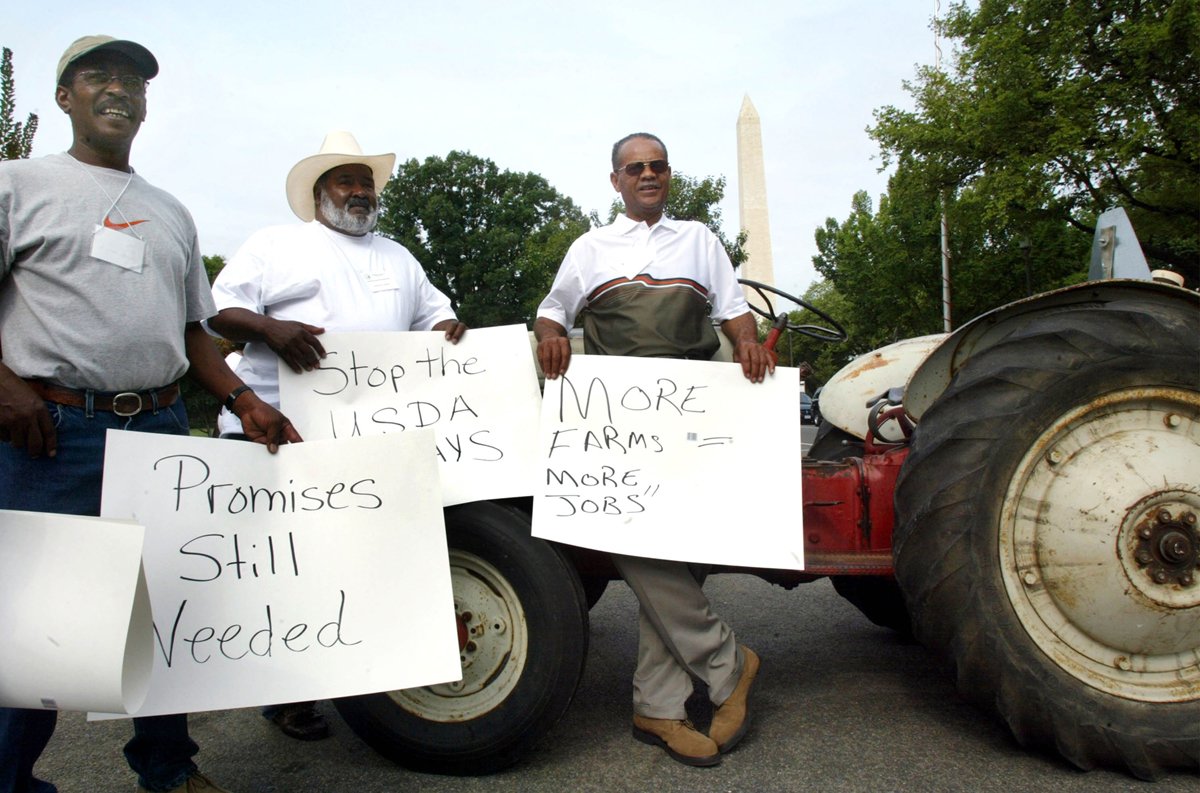Mar 8, 2022
The Field Report: Can Lawsuits Right Historic Wrongs For Black Farmers?

From left, farmers Loyd Johnson, Hezekiah Gibson, and Henry King from Manning, South Carolina, stand by a farm tractor during a National Black Farmers Association protest in front of the Department of Agriculture August 22, 2002, in Washington, D.C. (Photo credit: Mark Wilson/Getty Images)
Editor’s Note: Black-owned farms make up less than 2 percent of all farms in the United States. According to a 2020 report, Black farmers lost 80 percent of their farmland from 1910 to 2007, often because they lacked access to loans or insurance needed to sustain their businesses. Why is it so difficult to ensure equal opportunity and access in the agricultural industry? The time is now to demand better support for these businesses and work together to ensure that we’re breaking down barriers for Black farmers to enter the agricultural industry and succeed in it.
CONTENT SOURCED FROM CIVIL EATS
WRITTEN BY: LISA HELD
Plus, restaurant relief remains underfunded and updates to SNAP benefits coverage.
Over the last several decades, Black farmers and their families have used lawsuits to respond to decades of historic discrimination by government agencies. Now, the Federation of Southern Cooperatives/Land Assistance Fund has launched a two-year research project in an attempt to understand how that litigation has actually impacted the farmers and their families.
According to the organization, the research, which will be done in collaboration with The Institute for Economic and Racial Equity at Brandeis University, will focus on the experiences and voices of Black farmers who received settlements in Pigford v. Glickman. In Pigford, Black farmers sued the U.S. Department of Agriculture (USDA) for racial discrimination and earned what was—in 1999—the largest civil rights settlement in the history of the United States. And in the end, only 30,000 farmers were compensated.
“Now that it’s been enough time that we can possibly track some generational outcomes, we’re looking at whether that lump sum actually had a positive impact on the farm operation, families’ wealth, and overall economic stability,” Dania Davy, director of land retention and advocacy at the Federation, told Civil Eats. “We’re trying to evaluate whether class action litigation is an effective strategy in trying to repair some of this gross and horrific legacy of racial discrimination.”
More recently, an attempt by the Biden administration to provide debt relief to Black farmers was halted by lawsuits brought by white farmers. In November, we covered the Federation’s attempt to intervene in one of those suits, but a federal judge later rejected the motion. Additional attempts to correct injustices against Black farmers have so far been stymied; a new debt relief proposal is stalled within the Build Back Better Act, and lawmakers have introduced the Justice for Black Farmers Act multiple times, but it hasn’t moved through Congress.
The Federation is continuing its current fight in court through an appeal, Davy said, but as the case and new policies wind their way through the courts and Congress, the research project announced by the Federation will be focus attention on the people affected and give those fighting on their behalf more targeted insights into the right path forward. “It will help us better understand whether litigation is an effective means of advocacy . . . to address and mitigate the harms,” Davy said.
A Side of Sequestration. In other (very different) research news, a study published by a group of scientists from institutions around the world found that reducing the amount of meat eaten in high-income countries could have even more of an impact on reducing greenhouse gas emissions than previously thought. The researchers looked at the impacts of shifting high-income countries to the EAT-Lancet diet, which a previous panel of experts identified as an optimal way to eat for sustainability and health. The diet emphasizes fruits, vegetables, and whole grains and includes small amounts of meat, dairy, and fish. Researchers found that if the land freed up by reducing meat, eggs, and dairy was returned to its natural vegetation, it could result in a substantial “double carbon benefit.” By focusing attention primarily on high-income countries, the research also addresses some of the controversies that arose around the publication of the original diet in 2019—namely that it would be unaffordable for individuals in lower-income countries and that reducing meat consumption would negatively affect smallholder farmers there. Of course, how to ensure that the land is rewilded and not developed or used for other industrial purposes is an open question.
The Climate in D.C. After last week’s USDA announcements on expanding farm conservation programs, the agency turned its attention to research and fires. It announced a new $9 million investment in partnerships between Cooperative Extension programs at universities and USDA Climate Hubs to accelerate climate research and connect farmers more directly to climate-smart solutions and a 10-year plan to reduce wildfires. But while Agriculture Secretary Tom Vilsack followed up with a press release outlining his “key accomplishments” on climate since he took office a year ago, the Biden administration’s larger climate goals are on thin ice and activists are concerned the president won’t deliver on his promises. The Build Back Better Act, which was supposed to be the most historic investment in climate mitigation to date, is all but dead as a result of resistance from senators Joe Manchin (D-West Virginia) and Kyrsten Sinema (D-Arizona), and last week, two key staffers stewarding Biden’s climate and environmental justice agenda resigned.


